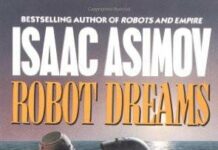
Ebook Info
- Published: 1991
- Number of pages: 288 pages
- Format: EPUB
- File Size: 0.25 MB
- Authors: Isaac Asimov
Description
A millennium into the future two advancements have altered the course of human history: the colonization of the galaxy and the creation of the positronic brain. Isaac Asimov’s Robot novels chronicle the unlikely partnership between a New York City detective and a humanoid robot who must learn to work together. Like most people left behind on an over-populated Earth, New York City police detective Elijah Baley had little love for either the arrogant Spacers or their robotic companions. But when a prominent Spacer is murdered under mysterious circumstances, Baley is ordered to the Outer Worlds to help track down the killer. The relationship between Life and his Spacer superiors, who distrusted all Earthmen, was strained from the start. Then he learned that they had assigned him a partner: R. Daneel Olivaw. Worst of all was that the “R” stood for robot—and his positronic partner was made in the image and likeness of the murder victim!
User’s Reviews
Editorial Reviews: From the Publisher A millennium into the future two advancements have altered the course of human history: the colonization of the galaxy and the creation of the positronic brain. Isaac Asimov’s Robot novels chronicle the unlikely partnership between a New York City detective and a humanoid robot who must learn to work together. Like most people left behind on an over-populated Earth, New York City police detective Elijah Baley had little love for either the arrogant Spacers or their robotic companions. But when a prominent Spacer is murdered under mysterious circumstances, Baley is ordered to the Outer Worlds to help track down the killer. The relationship between Life and his Spacer superiors, who distrusted all Earthmen, was strained from the start. Then he learned that they had assigned him a partner: R. Daneel Olivaw. Worst of all was that the “R” stood for robot–and his positronic partner was made in the image and likeness of the murder victim! From the Back Cover A millennium into the future two advancements have altered the course of human history: the colonization of the galaxy and the creation of the positronic brain. Isaac Asimov’s “Robot novels chronicle the unlikely partnership between a New York City detective and a humanoid robot who must learn to work together. Like most people left behind on an over-populated Earth, New York City police detective Elijah Baley had little love for either the arrogant Spacers or their robotic companions. But when a prominent Spacer is murdered under mysterious circumstances, Baley is ordered to the Outer Worlds to help track down the killer. The relationship between Life and his Spacer superiors, who distrusted all Earthmen, was strained from the start. Then he learned that they had assigned him a partner: R. Daneel Olivaw. Worst of all was that the “R” stood for robot–and his positronic partner was made in the image and likeness of the murder victim! About the Author Isaac Asimov began his Foundation series at the age of twenty-one, not realizing that it would one day be considered a cornerstone of science fiction. During his legendary career, Asimov penned more than 470 books on subjects ranging from science to Shakespeare to history, though he was most loved for his award-winning science fiction sagas, which include the Robot, Empire, and Foundation series. Named a Grand Master of Science Fiction by the Science Fiction Writers of America, Asimov entertained and educated readers of all ages for close to five decades. He died, at the age of seventy-two, in April 1992. Excerpt. © Reprinted by permission. All rights reserved. 1. CONVERSATION WITH A COMMISSIONER Lije Baley had just reached his desk when he became aware of R. Sammy watching him expectantly. The dour lines of his long face hardened. “What do you want?” “The boss wants you, Lije. Right away. Soon as you come in.” “All right.” R. Sammy stood there blankly. Baley said, “I said, all right. Go away!” R. Sammy turned on his heel and left to go about his duties. Baley wondered irritably why those same duties couldn’t be done by a man. He paused to examine the contents of his tobacco pouch and make a mental calculation. At two pipefuls a day, he could stretch it to next quota day. Then he stepped out from behind his railing (he’d rated a railed corner two years ago) and walked the length of the common room. Simpson looked up from a merc-pool file as he passed. “Boss wants you, Lije.” “I know. R. Sammy told me.” A closely coded tape reeled out of the merc-pool’s vitals as the small instrument searched and analyzed its “memory” for the desired information stored in the tiny vibration pattern of the gleaming mercury surface within. “I’d kick R. Sammy’s behind if I weren’t afraid I’d break a leg,” said Simpson. “I saw Vince Barrett the other day.” “Oh?” “He was looking for his job back. Or any job in the Department. The poor kid’s desperate, but what could I tell him? R. Sammy’s doing his job and that’s all. The kid has to work a delivery tread on the yeast farms now. He was a bright boy, too. Everyone liked him.” Baley shrugged and said in a manner stiffer than he intended or felt, “It’s a thing we’re all living through.” The boss rated a private office. It said JULIUS ENDERBY on the clouded glass. Nice letters. Carefully etched into the fabric of the glass. Underneath, it said COMMISSIONER OF POLICE, CITY OF NEW YORK.” “Baley stepped in and said, “You want to see me, Commissioner?” Enderby looked up. He wore spectacles because his eyes were sensitive and couldn’t take the usual contact lenses. It was only after one got used to the sight of them that one could take in the rest of the face, which was quite undistinguished. Baley had a strong notion that the Commissioner valued his glasses for the personality they lent him and suspected that his eyeballs weren’t as sensitive as all that. The Commissioner looked definitely nervous. He straightened his cuffs, leaned back, and said, too heartily, “Sit down, Lije. Sit down.” Baley sat down stiffly and waited. Enderby said, “How’s Jessie? And the boy?” “Fine,” said Baley, hollowly. “Just fine. And your family?” “Fine,” echoed Enderby. “Just fine.” It had been a false start. Baley thought: Something’s wrong with his face. “Aloud, he said, “Commissioner, I wish you wouldn’t send R. Sammy out after me.” “Well, you know how I feel about those things, Lije. But he’s been put here and I’ve got to use him for something.” “It’s uncomfortable, Commissioner. He tells me you want me and then he stands there. You know what I mean. I have to tell him to go or he just keeps on standing there.” “Oh, that’s my fault, Lije. I gave him the message to deliver and forgot to tell him specifically to get back to his job when he was through.” “Baley sighed. The fine wrinkles about his intensely brown eyes grew more pronounced. “Anyway, you wanted to see me.” “Yes, Lije,” said the Commissioner, “but not for anything easy.” He stood up, turned away, and walked to the wall behind his desk. He touched an inconspicuous contact switch and a section of the wall grew transparent. Baley blinked at the unexpected insurge of grayish light. The Commissioner smiled. “I had this arranged specially last year, Lije. I don’t think I’ve showed it to you before. Come over here and take a look. In the old days, all rooms had things like this. They were called ‘windows.’ Did you know that?” Baley knew that very well, having viewed many historical novels. “I’ve heard of them,” he said. “Come here.” Baley squirmed a bit, but did as he was told. There was something indecent about the exposure of the privacy of a room to the outside world. Sometimes the Commissioner carried his affection of Medievalism to a rather foolish extreme. Like his glasses, Baley thought. That was it! That was what made him look wrong! Baley said, “Pardon me, Commissioner, but you’re wearing new glasses, aren’t you?” The Commissioner stared at him in mild surprise, took off his glasses, looked at them and then at Baley. Without his glasses, his round face seemed rounder and his chin a trifle more pronounced. He looked vaguer, too, as his eyes failed to focus properly. He said, “Yes.” He put his glasses back on his nose, then added with real anger, “I broke my old ones three days ago. What with one thing or another I wasn’t able to replace them till this morning. Lije, those three days were hell.” “On account of the glasses?” “And other things, too. I’m getting to that.” He turned to the window and so did Baley. With mild shock, Baley realized it was raining. For a minute, he was lost in the spectacle of water dropping from the sky, while the Commissioner exuded a kind of pride as though the phenomenon were a matter of his own arranging. “This is the third time this month I’ve watched it rain. Quite a sight, don’t you think?” “Against his will, Baley had to admit to himself that it was impressive. In his forty-two years he had rarely seen rain, or any of the phenomena of nature, for that matter. He said, “It always seems a waste for all that water to come down on the city. It should restrict itself to the reservoirs.” “Lije,” said the Commissioner, “you’re a modernist. That’s your trouble. In Medieval times, people lived in the open. I don’t mean on the farms only. I mean in the cities, too. Even in New York. When it rained, they didn’t think of it as waste. They gloried in it. They lived close to nature. It’s healthier, better. The troubles of modern life come from being divorced from nature. Read up on the Coal Century, sometime.” Baley had. He had heard many people moaning about the invention of the atomic pile. He moaned about it himself when things went wrong, or when he got tired. Moaning like that was a built-in facet of human nature. Back in the Coal Century, people moaned about the invention of the steam engine. In one of Shakespeare’s plays, a character moaned about the invention of gunpowder. A thousand years in the future, they’d be moaning about the invention of the positronic brain. The hell with it. He said, grimly, “Look, Julius.” (It wasn’t his habit to get friendly with the Commissioner during office hours, however many ‘Lijes’ the Commissioner threw at him, but something special seemed called for here.) “Look, Julius, you’re talking about everything except what I came in here for, and it’s worrying me. What is it?” The Commissioner said, “I’ll get to it, Lije. Let me do it my way. It’s—it’s trouble.” “Sure. What isn’t on this planet? More trouble with the R’s?” “In a way, yes. Lije. I stand here and wonder how much more trouble the old world can take. When I put in this window, I wasn’t just letting in the sky once in a while. I let in the City. I look at it and I wonder what will become of it in another century.” Baley felt repelled by the other’s sentimentality, but he found himself staring outward in fascination. Even dimmed by the weather, the City was a tremendous thing to see. The Police Department was in the upper levels of City Hall, and City Hall reached high. From the Commissioner’s window, the neighboring towers fell short and the tops were visible. They were so many fingers, groping upward. Their walls were blank, featureless. They were the outer shells of human hives. “In a way,” said the Commissioner, “I’m sorry it’s raining. We can’t see Spacetown.” Baley looked westward, but it was as the Commissioner said. The horizon closed down. New York’s towers grew misty and came to an end against blank whiteness. “I know what Spacetown is like,” said Baley. “I like the picture from here,” said the Commissioner. “It can just be made out in the gap between the two Brunswick Sectors. Low domes spread out. It’s the difference between us and the Spacers. We reach high and crowd close. With them, each family has a dome for itself. One family: one house. And land between each dome. Have you ever spoken to any of the Spacers, Lije?” “A few times. About a month ago, I spoke to one right here on your intercom,” Baley said, patiently. “Yes, I remember. But then, I’m just getting philosophical. We and they. Different ways of life.” Baley’s stomach was beginning to constrict a little. The more devious the Commissioner’s approach, the deadlier he thought might be the conclusion. He said, “All right. But what’s so surprising about it? You can’t spread eight billion people over Earth in little domes. They’ve got space on their worlds, so let them live their way.” Read more
Reviews from Amazon users which were colected at the time this book was published on the website:
⭐This book is an absolute masterpiece and one of Asimov’s best which says a lot since he wrote over 500 books. In Caves of Steel Asimov sets the stage for a future where robots are integrated into society, albeit begrudgingly, and weaved into mysteries. Introducing the new crime-fighting detective duo, Baley and Daneel this book kicks off one of the best series in SciFi history.Asimov’s descriptive writing style and fantastic world building makes this a real treat and a glimpse and true literary perfection in every sense.
⭐I loved this book. It offered a look at an alternate future where overpopulation has fractured man into two camps. Earthlings never trusted their robot creations, preferring to keep them hidden or out of sight. Spacers embraced robots and looked to them for security and performing all the small tasks to which we’re accustomed. The result is that people on Earth have lived in climate-controlled covered cities that sprawl not only above ground but below, and lived there so long that the act of being outside and exposed to nature brings forth anxiety attacks. Earthlings feel safe when they know there’s people and walls all around them. Spacers, on the other hand, have taken over 50 other worlds and place more emphasis on privacy and independence, with the unacknowledged exception being their dependence on robots to watch over and protect them.The world-building in this series of novels is very deep and detailed. All citizens of Earth are given the necessities to live, but only just enough. You get basic food, a place to sleep, and a little bit of access to recreational services. Everyone is classified according to their jobs and contributions, and the higher a classification you have, the more you are entitled to. Higher classifications get better and bigger apartments and a wider selection of food. And with food being served in cavernous cafeterias, sometimes one even gets to occasionally prepare their own meals in their own kitchens, if their rating is high enough. Bathrooms are rarely in the apartments assigned to citizens, and instead are large and sprawling communal areas where different societal norms have taken hold. Women tend to chat and socialize extensively in their “Personals”, while men, in an attempt to afford each other privacy, have developed a deep aversion to acknowledging in any way other residents (never look at someone, and never ever speak inside a Personal). The difference between the two sexes almost seems a bit sexist, but in reality just reflects some of the views towards the sexes that exist even to this day. Later books in the series where life is shown on Spacer worlds shatter these conventions and seem foreign to our protagonist. All in all, it’s a fascinating background in which the story unfolds.And the story is a simple murder mystery. Elijah Baley is a detective in NYC’s police department. NYC, incidentally, has grown over the centuries, and grown so large that cities like Trenton, NJ are considered boroughs and are part of the enclosed city-structure. There is a settlement of Spacers called Spacertown outside of NYC, and a prominent roboticist has been murdered. This creates a bit of a political crisis. Spacers have advanced their technology and can enforce their will upon Earth and Earthlings, who have been content to just live in their covered cities. Spacers tend to strongly dislike Earth, and there is a very real and substantial fear that Spacers may take control of Earth. Having one of their prominent citizens murdered will only enhance this, and it’s up to Detective Baley to resolve this murder. He is assigned a partner in the form of R. Daneel Olivaw, a humaniform robot (one so lifelike it’s hard to tell apart from a human). Daneel is one of only two robots in existence who are like this. Baley must get over his inherent dislike of robots that all Earthlings feel and work with Daneel to find the murderer and quell the rising unease between Earth and the Spacers.Isaac Asimov is not exactly a poet with his writing, but he’s very effective and clear and professional, and his world-building is superb. His attention to details draws the reader in and makes for a very effective mystery. Like all good sci-fi writers, he doesn’t lose sight of the story during the process of introducing the reader to the science. By the time the story is resolved, the reader does enjoy Baley and Daneel, and has the pleasure of looking forward to reading more about them in the two follow-up stories, “The Naked Sun” and “The Robots of Dawn”. Those two take place on two different Spacer worlds, and in some wonderful writing, the differences in those worlds is as dramatic as the difference is between the futuristic Earth of “The Caves of Steel” and our own present Earth. If you enjoy science-fiction that introduces new advanced concepts and worlds and ideas, but still enjoy being not so far removed from our own world that everything is unfamiliar, this is a wonderful story in which to indulge.
⭐I’ve always been a great fan of Asimov and can’t wait to read this book. The cover is attractive so I picked this book after deciding what to read next from him. Will do a thoroughly review once I read it.
⭐This book is prescient in so many ways. The ethics of robotics and its effects on society based upon mid-century knowledge is great.
⭐“There were some eight hundred Cities on Earth, average population, ten million.Each city became a semiautonomous unit, economically all but self-sufficient. It could root itself in, gird itself about, burrow itself under. It became a steel cave, a tremendous, self-contained cave of steel and concrete.”This was my first go and foray into the world of Isaac Asimov, which is a pity because I have been missing out for years. Asimov’s The Caves of Steel is one of the novels in his Robot Series, and the novel’s title is sort of a metaphor to describe the basic structure of these “mega” cities with vast populations. I think most notable about the novel is the way Asimov can visualize, create, and set up with society and world, with the humans, robots, and Spacers. Likewise, the novel sprinkles in various thinking points and philosophical questions that make for a thought-provoking read.Interestingly, the novel is set up as both a mystery/crime as well as a science-fiction. The basic premise involves veteran New York City police detective Elijah Bailey being assigned the investigation of a suspicious murder of one of the prominent Spacers. As part of the investigation, Bailey teams up with a robot, R. Daneel, to help him search for the suspect and solve the crime.As mentioned earlier, it is interesting to see how the robots and humans coexist with each other and must live in the same society. We see this in Bailey’s natural distrust and dislike of the robots. His skepticism about his robot partner is one of the conflicts we follow, and this is explored more deeply as we move along in the novel. Bailey’s negative attitude about his fellow robots seems to be a microcosm of angst brewing within the general populace. One key scene early on that illustrates this is a near riot at a store that Bailey and Daneel get called to investigate. Human resentment over robots taking jobs in the work industry is one such factor in this friction.And, while the mystery itself might be pedestrian (that is, until the final few chapters where the book seems to hit another gear), all is forgivable because the book is such an engaging and compelling read in various other ways. The idea and set up of society that Asimov projects is quite fascinating and imaginative. He spends quite a bit of time giving background and context to how things work and the basic history of where we are. One point illustrating this is when Bailey must cross lines and had into Spacetown with Daneel as part of his investigation. Bailey’s point of view and perspective sheds light on how things operate in Spacetown.I thought both the science fiction and mystery elements were fused together nicely and worked in tandem with each other. The momentum really picks up in the final chapters as we head towards the conclusion. I also thought it was effective how Asimov does enough to give the book a sense of closure, yet also keeps the door open by setting up the next installment in the series.
⭐What a treat, Asimov’s 1st Robot story, and what a wonderful story, indeed. This story sets the stage for all of the others, so definitely read this, trust me. You’ll also find it a fairly fast read, too, though don’t mistake this for a simple story, because it’s anything but.
⭐Good Murder mystery. This book is the basis for the movie, “I, Robot”. You won’t guess who did it until the very end.
⭐This was a gift I gave to my daughter this past Christmas. She was very happy to receive it.
⭐One of the best of Asimov’s considerable body of work. The enclosed city and its moving walkways hark back to H G Wells, but the main theme of the novel, the social and evolutionary aspects of the introduction of robots, is all Asimov’s own. In particular, his use of his famous laws of robotics and the role they play in a “murder”. One of the flaws of the established Asimov is that his story and his characters can suffer from an overweening tendency toward philosophical explaining, as if success stimulated an over confidence, as it did with Wells also, in my opinion. This doesn’t happen here. Baley is a recognisable and sympathetic protagonist, understandable and very human and the plot is not overpowered by philosophical debate concerning the future of mankind, whilst at the same time many an interesting and arresting conversation does fall aptly into its natural place in line with the novel’s developing themes. Very engrossing and worth re-reading (fourth time for me). The sequel “The Naked Sun”, whilst not quite as good is also well worth reading.
⭐Caves of Steel was written in 1954 by the remarkably ever prescient Asimov and, chronologically, is the first in his suite of “future histories”. The book is tinged, of course, with a 50’s optimistic vision of how they saw the future: robots, speeders, space travel (and still with people smoking tobacco) but you HAVE to admire Asimov’s ability to start predicting things that we have either seen come to pass or at least are looking more and more likely.His insight into the “human condition” and what motivates mankind to evolve/excel/invent/revolutionise is nothing short of remarkable.In this novel he gives us a vision of what earth might look like in 1,000 years with an ever burgeoning population – a strain on Earth’s resources along with a sort of inevitable erosion of some of the forces that had previously driven mankind through the millennia to expand. He sees a risk-averse, conformant homogenised society – ring any bells with modern globalisation and our very present “health and safety” risk-averse society we can see ‘blossoming’ before our very eyes? This, he identifies, is the problem with earthmen of 1,000 years plus. Consider this … would Christopher Columbus ever have set sail if he’s had the “health & safety” brigade doing risk assesments on his “project proposal” to set off into the unknown to discover a hypothetical ‘new world’?He develops this theme into how mankind can get out of this sociological ‘cul-de-sac’ in an intriguing and thought provoking way.
⭐After seeing the film, I Robot, I had very high expectations for this book, the first in his robot series. It is good, but I was a little disappointed. The idea of a human robot is present, with the positronic brain and the author has taken it a step further by making it look human. However, there is no desire to understand or explore human emotions compared to I Robot (the film). The book does make a good distinction between the way Baley speaks and the robot Daneel. You can tell the thought processes are different and there is a desire to learn and fit in with human society.I like the idea of Medievalists who oppose the spread of robots and technology in general. The commissioner’s use of a disguised window is one example. I found the idea of Spacers a little unclear. At first, I wondered if they were robots, but they just use robots as useful tools. They are in fact the original descendants of earth. They are the ruling elite who keep the new settlers in megacities, ration food and enforce a classification linked to privileges. These people fear robots will come and take their jobs away resulting in de-classification.The murder mystery element of the book is a little forced in the sense that it does not flow smoothly. The clues to the identity of the murderer and their motives are in the book and there is a logical revelation at the end, but it lacks the sophistication readers may expect.I think Asimov, like Huxley, is a brilliant scientist but lacks literary technique in the modern sense of the word. His novels will be read for their insightful ideas, not for their literary brilliance.
⭐Is such a shame that whoever wrote the synopsis for amazon didn’t actually bother to read the book before they write it. Anyone who actually does read the book will discover early on that the New York City we know lasted for at least 3000 years before the New York City that becomes The City of the story comes into being and this new City is several hundred years old at this point.Ok, that’s the gripe about the synopsis over and done with.Earth, thousands of years into the future. Massively overpopulated ever everyone loves in one of 800 Cities – enormous structures that protect their population from the outside, the feed them, Clothe then and nurture them. There is nothing wrong with the outside, it’s just that people have been closeted in the Cities for so long that they simply don’t go outside. On the outskirts of New York is Spacertown. A reminder to earth that it lost the war against is one time colonies of in the stars. Spacertown is where the ever arrogant and superior spaces stay when visiting old Earth. And now one of them is dead. Murdered. A major diplomatic incident needs to be avoided as any such week price very costly for dear old Earth. Plainclothesman Elijah Baley , C5 rated, of the New York police department is assigned the case along with a partner from the space community. Solving the case will save Earth and will also save Elijah Baley and his family , because fake is not an option.I’ve always loved the good doctors books and these books that start what turned into the Robots and Foundation series, a massive conglomeration of a lot of his scifi works, are among my favourites of all. If you can find ‘I, Robot’ and ‘The Rest Of The Robots’ these will give you a great background info the Asimov Robots, robots built upon a foundation of ethics, the laws of robotics. a more modern collection is ‘The Complete Robot’ anthology.With this book and is follow ups (‘The Naked Sun’ and ‘Robots Of Dawn’) we meet one of Asimov’s most loved characters, Elijah Baley. An Earth detective called on to solve the most difficult of crimes – murder. Elijah is human, fallible and capable in equal measure. He has to offer come his feelings and failings as he feels into the complicated world and lives of the Spacers.Surely one of the best characters ever created. Elijah Baley seems to blunder around the problems accidentally finding the solution to the tricky problems with which he is faced. He is so completely human, timelessly so. Thrown into situations that no school could ever prepare him for, he’s so it off his depth and comfort zone. But somehow he finally sees the core, the one thing that let’s him solve the problem.Alongside our good detective is his Space partner, Danieel Oliver, their to smooth ruffled father’s and explain the Society and technology that no man of Death could ever hope to understand otherwise.The characterisations are brilliant and the stories are well crafted for all that they were created and published back in 1950.
⭐The print is absolutely terrible, too small, bold and blurry. Also it’s quite crocked (as in inclined lines), printed by amazon, absolutely painful for the eyes and the soul. I returned it. There’s other publisher edition in amazon, printed by a real printer and much better, look for that one, which by the way, is also cheaper….As per the book, good classic Asimov, always great writing, great stories
Keywords
Free Download The Caves of Steel (The Robot Series) in EPUB format
The Caves of Steel (The Robot Series) EPUB Free Download
Download The Caves of Steel (The Robot Series) 1991 EPUB Free
The Caves of Steel (The Robot Series) 1991 EPUB Free Download
Download The Caves of Steel (The Robot Series) EPUB
Free Download Ebook The Caves of Steel (The Robot Series)





